This Easy Homemade Rye Bread made with caraway seeds tastes delicious and is a wonderful, wholesome change for sandwiches, toast, or just served with butter along with a meal.
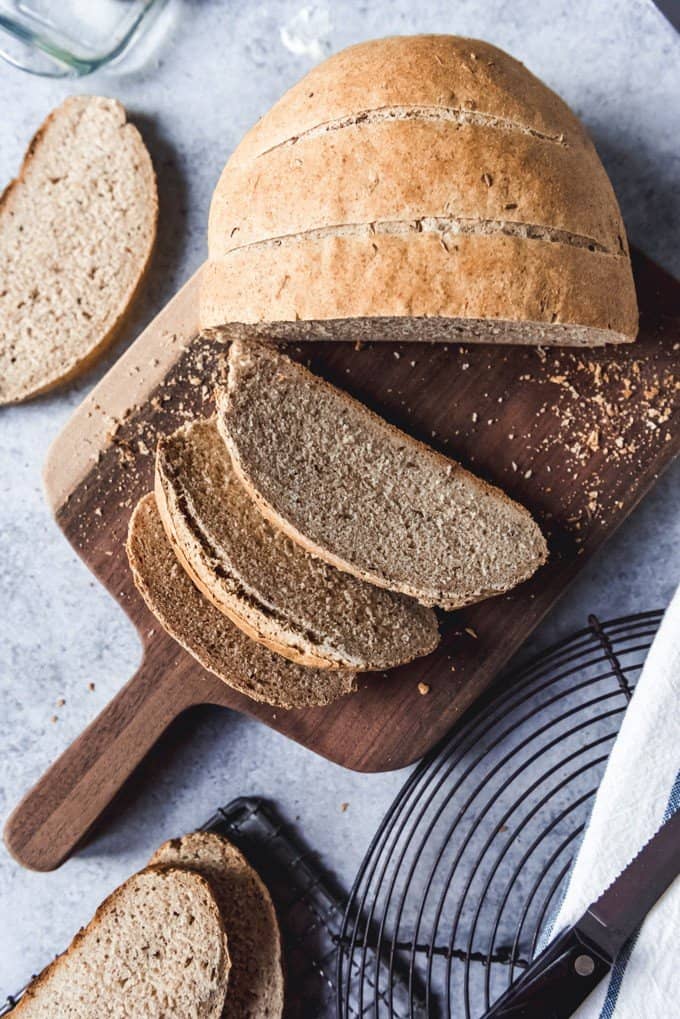
There is nothing like loaves of homemade bread coming out of the oven. Some of our other favorites are Sweet Molasses Brown Bread, Easy Rosemary Focaccia Bread, and Amish White Bread.
You’ll love this Light Rye Bread
I am a big-time bread fan, whether it’s a sweet molasses brown bread, a classic loaf of french bread, or a strong caraway rye bread. Bread is one of my favorite foods.
Since I had never made rye bread before, I looked to a lot of resources online to get an idea for how to approach it and what kind of rye bread would work best for my family.
I found this post from the King Arthur Flour site to be super helpful in describing different types of rye bread, if you want to try something a little darker or different than the light sandwich rye that I am sharing today.
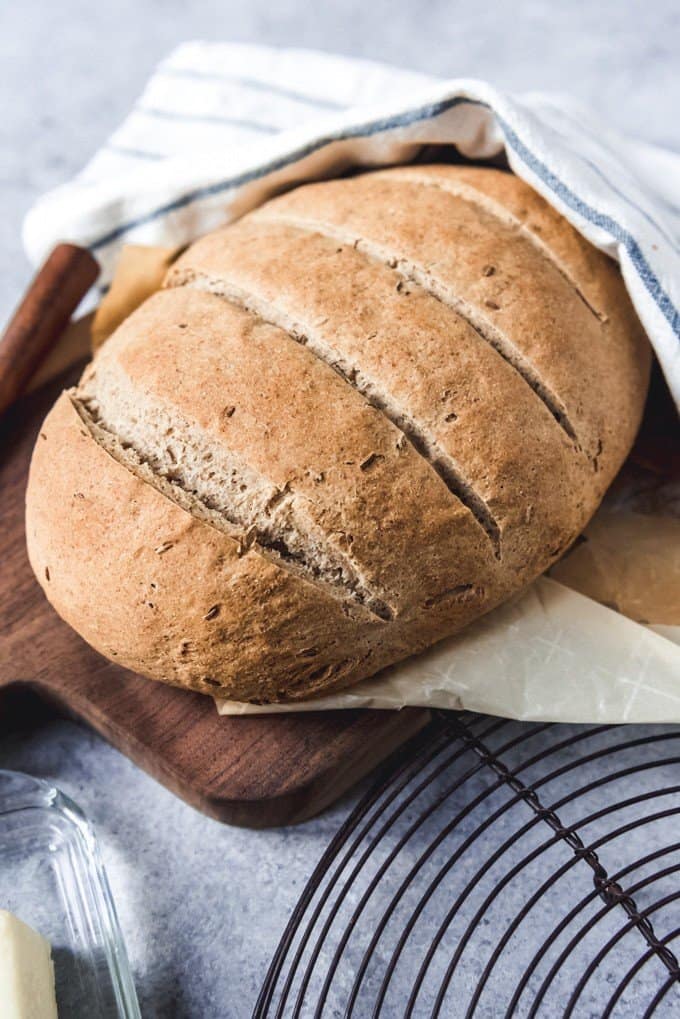
What is Rye Bread?
Rye bread can run the gamut from a fruit-and-nut studded loaf to a classic sourdough rye, to the dark, dense pumpernickel (another of my favorite breads that I want to make one of these days!) which is actually a type of rye bread.
And then there is the light, caraway sandwich variety, which is the kind I decided to make.
I wanted to share a simple rye bread recipe that would taste as good with butter and jam at breakfast as with cheese and lunchmeat for a sandwich later in the day.
The reason caraway seeds matter in this bread is that rye bread actually has a fairly mild flavor on its own.
So kneading seeds like caraway, fennel, or anise into the dough or sprinkling seed mixes like Trader Joe’s Everything Bagel Topping on top will give distinctive taste to a loaf of rye bread.
Caraway seeds are what are in the rye bread at my favorite German restaurant, so that’s what I went with this time around.
What does Rye Bread taste like?
Rye bread has a distinct and unique flavor profile compared to other types of bread, like wheat or white bread. It’s characterized by its earthy, slightly tangy, and nutty taste. The taste of rye bread can vary depending on the type of rye used, the proportion of rye to other grains (such as wheat), and the baking process. Rye bread can exhibit a mild tanginess, similar to sourdough bread. This tanginess is usually a result of the fermentation process, where natural yeasts and bacteria break down the starches and produce lactic acid. Also, rye bread is typically denser and heavier than traditional white bread due to the lower gluten content of rye flour. This density can contribute to a satisfying chewiness.
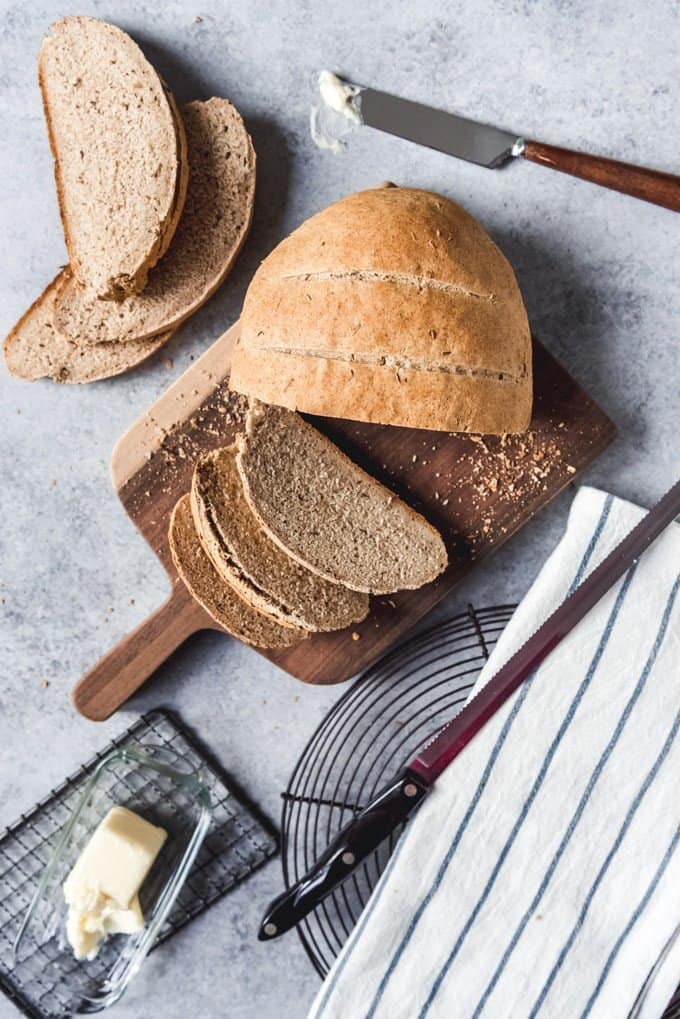
My friend Jenni from The Gingered Whisk and I have been doing a series for the past year where we look at old recipes from a specific time period and recreate them in our home kitchens to feed to our families. Sometimes we try to keep the recipes as close to their historical roots as possible, and other times we tweak them to fit our modern palates.
My first post in the series was last October when I shared a beef steak pie recipe from the Salem Witch Trial period in colonial America.
For this installment, we decided to attempt foods from the Middle Ages, which turned out to be pretty challenging for me. Medieval food recipes are pretty out there, and the more I researched about food in medieval times, the more I realized that I needed to distinguish between the food of the rich and the food of the poor because what you ate was very strongly influenced by where you were in society.
In the Middle Ages, there was a well-defined hierarchy to the social structure with royalty at the top, followed by nobles, then knights, then the clergy, then tradesmen and peasants. You were born into a class of people and generally stayed there your entire life, with very little opportunity for advancement.
I ended up choosing a food that better represents that poor peasant class (even though this homemade rye bread recipe is actually still much better than what peasants would have had access to since I used wheat flour along with rye flour), and Jenni made Sheet Pan Spiced Pork Meatballs in Almond Sauce with Roasted Vegetables, which is based on an actual medieval recipe and represents the food of the higher classes who had access to much more protein and many more spices to vary their diet.
I have seen recipes very similar to the one I am sharing described alternately as Jewish, Polish or German. I didn’t do any in-depth research into the differences of each, but from a cursory look at quite a few different recipes, I would say this is closer to the Jewish or Polish versions.
Although it makes sense that this would be classified German as well because it tastes very much like the bread served at our favorite authentic German restaurant in San Francisco.
When were the Middle Ages?
The Middle Ages, also known as the Medieval Period in Europe, lasted from the 5th to the 15th centuries. There are actually three different periods known as the Early, High, and Late Middle Ages, each with their own distinctions, but we didn’t decide to focus on any one period when selecting our recipes.
It’s a fascinating, confusing time in history though, with changes like the rise of kingdoms and the social structures that we typically think of when looking back at the middle ages. Knights and nobles controlled lands that were rented to peasants who were organized into small villages.
There was climate change known as the medieval warm period that increased the ability to grow crops, followed by plague and famine and war. It must have been a tough time to be alive.
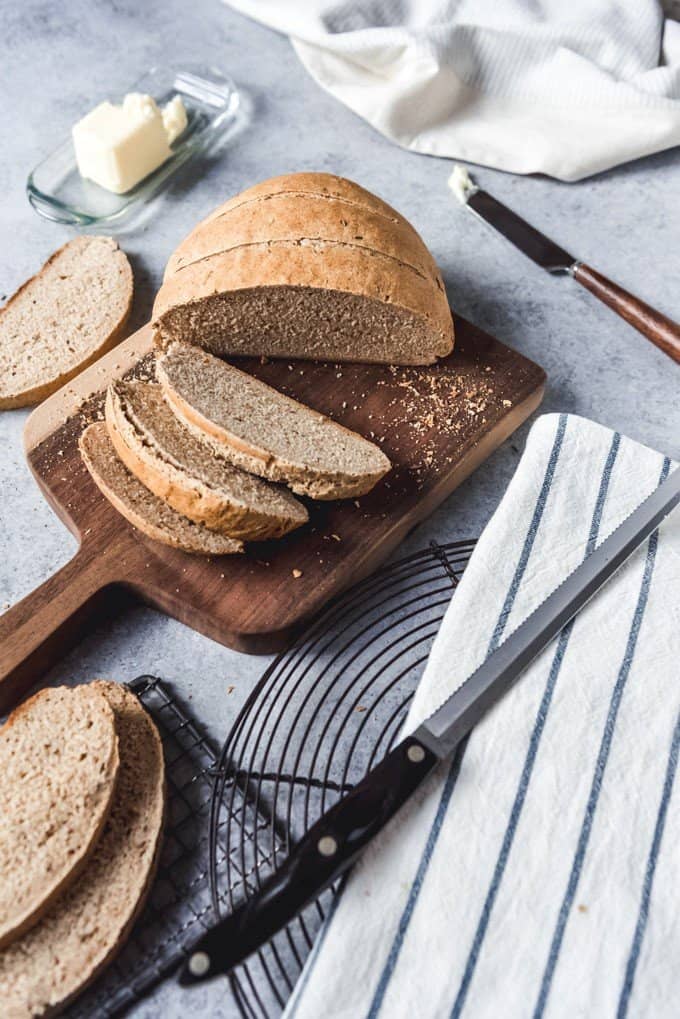
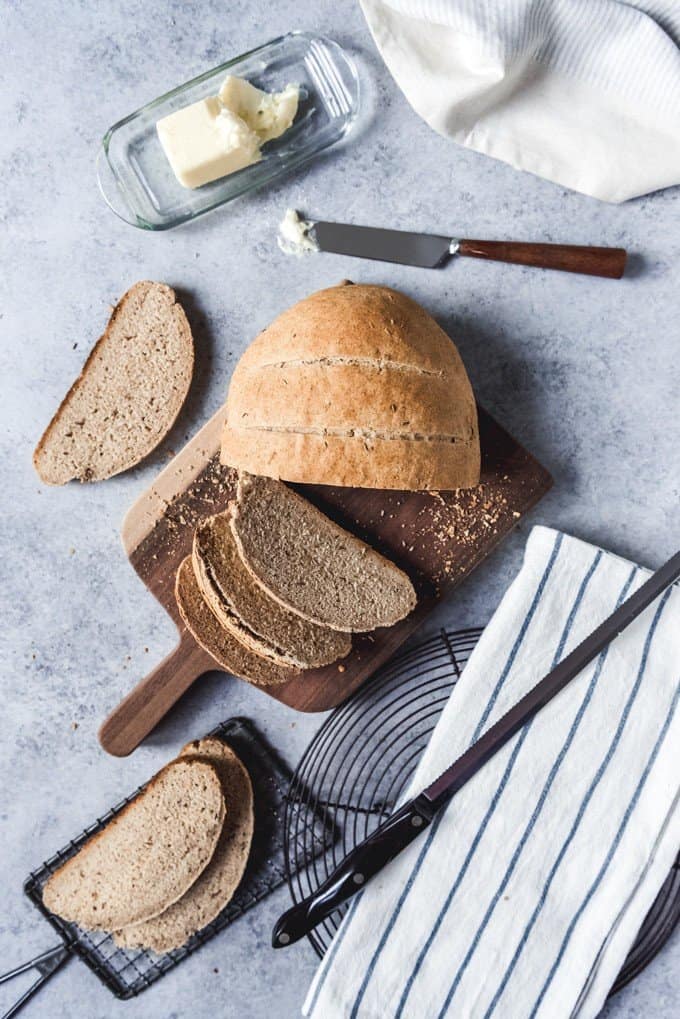

Is Light Rye Bread Good for You?
I’m not a nutritionist, but I can tell you that rye bread is lower in gluten content than other, all wheat flour breads. This version still has wheat in it, so it isn’t gluten-free, but it is lower on the glycemic index so it is less likely to spike your blood sugars than all-white bread.
Rye bread also has higher fiber content than white bread. And since this is homemade bread, it’s free from preservatives and additives and all that other stuff.
Plus, I don’t know, it just tastes like it is doing good things for you. And that has got to count for something!
Rye Bread Ingredients
- Flour – I like to use a combination of bread flour, whole wheat flour, and of course rye flour in my rye bread.
- Honey – For just a hint of sweetness and to help the yeast get going.
- Active dry yeast – If using instant yeast, you can skip proofing the yeast and go straight to mixing the other ingredients together.
- Warm water – This shouldn’t be too hot or too cold or the yeast won’t proof. It should be around 110-115°F.
- Milk – A little whole milk adds depth of flavor to the bread loaf, but plain water can be used instead.
- Salt – So the bread doesn’t turn out bland.
- Vegetable oil – A little fat helps give the bread a moist crumb.
- Caraway seeds – These are for even more flavor and they are delicious, but you can omit them if you don’t care for them.
How to make Rye Bread
I think it’s clear by now that my recipe for homemade rye bread differs from authentic Medieval bread, especially the kind that would have been eaten by the lower classes, for a few reasons.
One of those reasons is that I use yeast to leaven the bread and make a soft loaf that is delicious to eat sliced and spread with butter.
I also combined three different types of flour – rye flour, whole wheat flour, and bread flour, to get a softer, more tender bread with more “lift” than 100% rye bread.
But even with these changes, this bread is certainly different from the standard loaves you might get at the store. And it’s a great way to introduce your family to new flavors that are a little more unusual than what they might be used to.
Making this homemade rye bread uses the same techniques as making any other loaf of bread. Start by proofing your yeast in some warm water with a little honey.
Then it’s just a matter of kneading in a little salt with the different types of flour and the caraway seeds.
Incidentally, if you are wondering what else to use caraway seeds for so they aren’t just sitting in your cupboard for making loaves of rye bread, try this rotkohl recipe or sauerkraut and sausages with apples that is one of our family’s favorite dinners during cold weather months.

The loaf might take a bit longer to rise than most loaves since rye has less gluten in it, but the shaping and baking are all the same.
You could bake this homemade rye bread in a bread pan for a higher “sandwich” looking bread, or just place it on a baking sheet on a piece of parchment paper for a more rustic, artisan looking loaf like you see in these pictures.
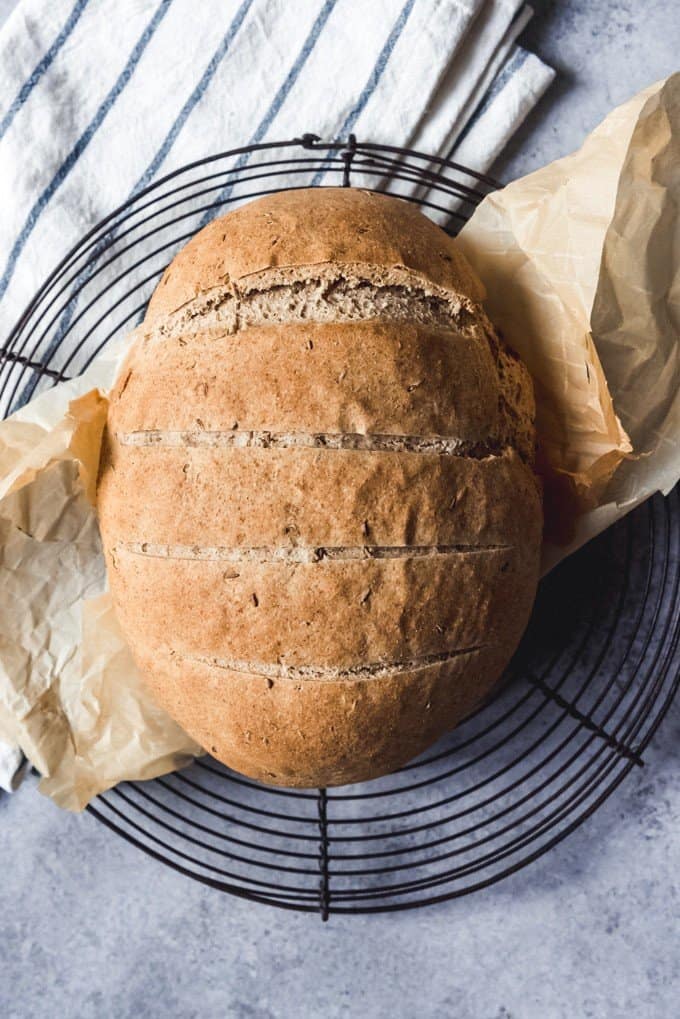
Then slice and enjoy! Do you like to make bread at home? Let me know what kind in the comments below!
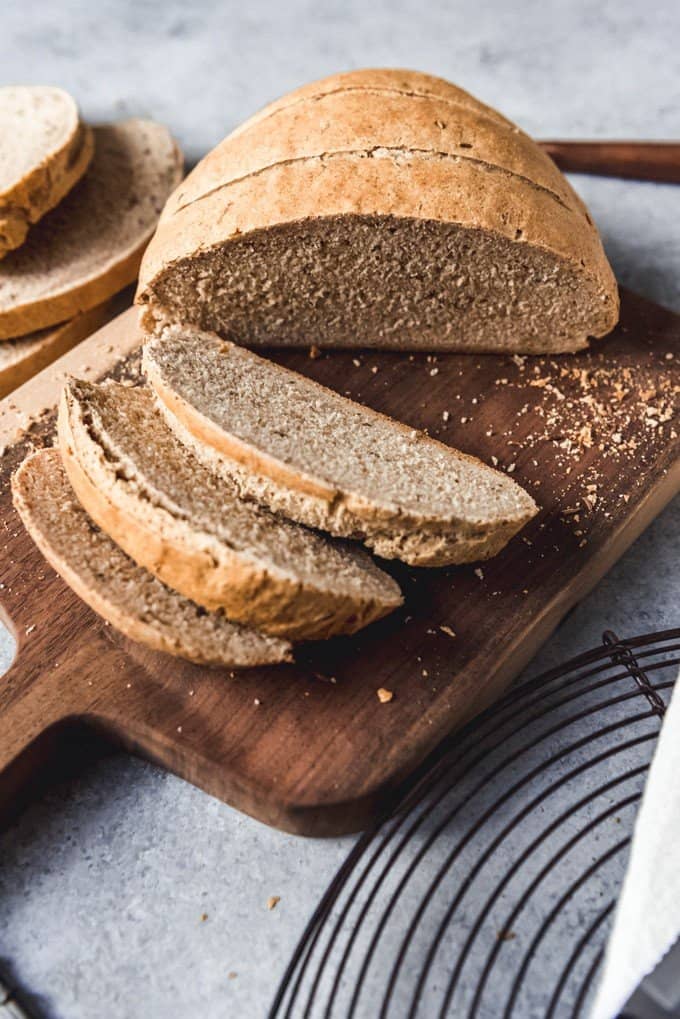
Ways to Serve Light Rye Bread
Light rye bread, with its slightly milder flavor compared to dark or whole grain rye bread, can be versatile and delicious in a lot of ways! Try using it for sandwiches, toast, bruschetta, French toast, panini, or alongside soup.
How to Store This Easy Rye Bread Recipe
Once completely cooled, wrap your loaves of rye bread in plastic wrap and store in an airtight container or bag for up to 3-4 days. Like most homemade breads, it’s best when fresh the day it is made, but you can use stale rye bread to make croutons, add to stuffing recipes, or even make French toast!
Freezing Homemade Rye Bread
To freeze a loaf of homemade rye bread, simply let it cool completely, then wrap it well in plastic wrap and store it in a freezer safe ziploc bag for up to 2 months. Thaw on the counter for a couple of hours before slicing and enjoying.
More Like This Light Rye Bread Recipe
More Favorites from House of Nash Eats
Did you make this recipe?
Let me know what you thought with a comment and rating below. You can also take a picture and tag me on Instagram @houseofnasheats or share it on the Pinterest pin so I can see.
Rye Bread Recipe (Easy!)
Ingredients
- 1/2 cup warm water (about 110-115°F)
- 1 Tablespoon honey
- 1 1/2 Tablespoons active dry yeast
- 1 cup whole milk, room temperature
- 2 teaspoons table salt
- 2 Tablespoons vegetable oil
- 1 to 1 1/2 cups bread flour
- 1 to 1 1/2 cups whole wheat flour
- 1 1/2 cups dark rye flour
- 2 Tablespoons whole caraway seeds
Instructions
- In the bowl of an electric stand mixer fitted with a hook attachment, combine the warm water and honey, then sprinkle the yeast on top of the water and let it proof for 5 minutes.½ cup warm water, 1 Tablespoon honey, 1 ½ Tablespoons active dry yeast
- Add the milk, salt, oil, bread flour, whole wheat flour, rye flour, and caraway seeds to the yeast mixture and knead on medium-low speed until the dough starts to come together. I always start with the lower amount of bread and whole wheat flours listed, then add more as needed.1 cup whole milk,, 2 teaspoons table salt, 2 Tablespoons vegetable oil, 1 to 1 ½ cups bread flour, 1 to 1 ½ cups whole wheat flour, 1 ½ cups dark rye flour, 2 Tablespoons whole caraway seeds
- Increase the speed to medium-high and knead for 8-10 minutes until the dough is smooth and no longer sticking to the sides of the bowl.
- Place the dough in a large, lightly oiled bowl and cover with a towel. Let the dough rise in a warm place until doubled in size, about 1 ½ hours.
- When the dough has risen, punch it down and transfer to a clean work surface. Let it rest for 5 minutes, then shape it into a loaf and transfer to a baking sheet lined with parchment paper. Cover with a towel and let rise for another hour until doubled in size again.
- When the dough is close to being doubled in size, preheat the oven to 425°F. Slash the dough with a sharp knife to create gashes on top. Open the oven and throw a few ice cubes on the bottom when you place the bread in to bake. This will create steam that will make for a great crust to the bread. Bake for 30 minutes until crusty and golden brown.
Notes
- Rye flour has a lower gluten content than regular flour, so it will typically take a little longer to rise than other loaves.
- I had a previous omission in the recipe where I had typed in 3 cups of bread flour and 1 ½ cups of the rye flour. I have since changed it to 1 ½ cups of bread flour, 1 ½ cups of whole wheat flour, and 1 ½ cups of rye flour. I find that both ways work, but the version with the whole wheat is heartier.

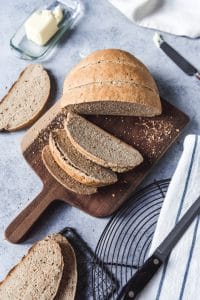
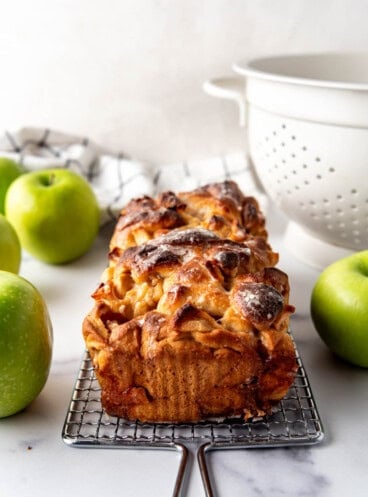

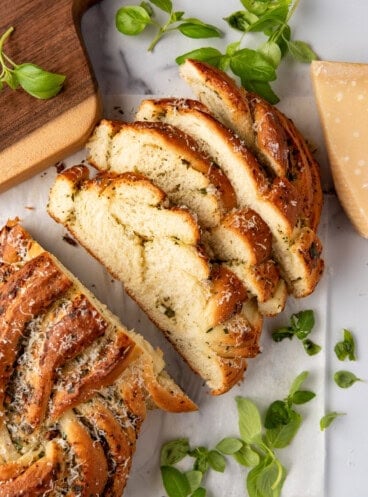
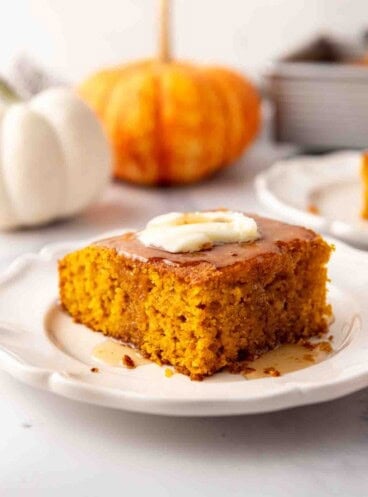

My first time making rye bread and this came out fantastic..i will definitely be using this recipe again
I added 1/8 cup of vital wheat gluten.
I’m very happy with the results.
I’m at 6000 feet so it’s necessary to play with the time and temperature.
And don’t forget the moisture in the oven.
Thanks for a great recipe.
Is the kneading time 8-10 minutes of it in a stand mixer? I thought that 2 minutes of kneading in a stand mixer = 10 minutes by hand, so I don’t want to over-knead the loaf.
In this case, since rye has much less gluten in it than flour, I kneaded it longer than I normally would. So yes, about 8 minutes in the stand mixer.
In the text you say you used three types of flour, but in the recipe it just says use bread flour and rye flour. Is it correct to use just the two flours? thanks.
Thank you for pointing that out! Somehow I combined the whole wheat and bread flour measurements together. Which would work, but I fixed it and separated out the amounts!
Amy, what was the old version of the recipe? I made it twice using the version that only listed two flours and the bread turned out great, and then recently I tried it again and it’s not coming out right. I felt like I was crazy until seeing this comment about the change, so hopefully you can help me figure out what’s different. Thanks.
I’m so sorry for the confusion, John! I added a note to the recipe for anyone else who experiences the same thing. But the previous measurements were 3 cups of bread flour with 1 1/2 cups of rye flour. All I did was separate those out to 1 1/2 cups bread flour and 1 1/2 cups of whole wheat flour with 1 1/2 cups of rye flour still.
So I just made this and it seemed like a very dry dough….I added a little more water and it seemed to come together better….it’s rising now so I will let you know how it turns out!
The easy rye bread was hard to work with.
Hi Amy. I am not use to use “cup”. How could I convert “cup” to gram? I searched internet I found different results for flour: 1 cup= 98 gram, 120 gr, 128 gr. Which one I should accept as the right measurement?
Thanks.
My understanding is that 1 cup of flour is equal to 120 grams.
Hi Amy. Thanks for the great article. It took some modifications for me to make this work, partially because I live at 10,000ft and partially because making bread by hand at less than 50% hydration is really not easy. I don’t use a mixer – ever. This bread is a lot easier to make at 70% hydration (hearth-baked) and 75% in a cast iron pot. Also, one thing that really made a difference in the taste was to ferment the bread in the refrigeration instead at room temperature (2 days). I liked it better that way, but other bakers may not. One thing that would help is if the recipe was showed measurements by both weight and volume. I know a lot of bakers use volume, but it’s much easier to manipulate the size of the loaf by weight. Anyway, thank you for the great recipe.
Thanks for posting about elevation Ron. I’m at 8000feet and have a hard time. What were some modifications you made aside from refrigerating? Thank you
Hi Amy,
Have you tried substituting dry yeast for wild yeast with this recipe?
I have not, sorry!
Hi Amy,
The wild rye starter I have works great with your recipe. 50 grams is what I used(the converted said 25 grams but I used more.
Thank you for sharing that! I’m so glad to know!
Sorme researchers say rye bread is the healthiest bread to eat. Rye bread does not spike blood sugar, unlike the other breads.
Very tasty recipe, I love it. I did have to add more milk (about 1/4c extra) during the mixing because it was too dry but it came out great and I will be making this more.
Do you REALLY mean 1 1/2 TABLESPOON dry yeast in the Easy Rye Bread recipe? Is that over two envelopes for 1 loaf?
Yes, that’s the amount I use, although you can certainly go with a smaller amount. It will just take longer to rise. Adding more yeast to a recipe helps it rise faster, even when a smaller amount of yeast would work to leaven the broad over a longer time.
When I do the second prove it just flattens out. What am I doing wrong?
If it is flattening out during the second proof, try adding a little extra flour next time, checking your yeast to make sure it’s still good, or making your loaf in a loaf pan to give it some support.
Why does my bread come out flat for the second rise?
That seems strange that it would rise the first time but not the second. I would immediately say to check the yeast to make sure it’s still good, but if it is rising the first time around then I would think the second rise would happen just as well. Maybe try it in a bread pan to contain the bread and help it rise up instead of flat.
When you say wholemeal flour do you meal wholemeal strong bread flour or standard?
I’m not sure what the difference is between wholemeal strong bread flour or standard as I haven’t heard it described in those terms before. I just use a regular bag of bread flour from the store for part of the recipe, then the rye flour and the whole wheat flour.
Brilliant recipe. I’ve been making this bread recipe all month and love it. I’ve been making previous loafs (using this recipe) with a hand mixer. Have just tried with a food processor. Comes out the same but less time mixing. Thanks for a great recipe.
I’m so glad to hear you love it so much!
Can I bake this in a Dutch Oven? And if so what temperature and time.
Thanks. Kind regards Christina
Hi Christina! I’m sure you could, but I haven’t tried it so I can’t give you specifics on temperature and time. I would recommend starting with the same temp and 5 minutes less bake time than that listed in the recipe and then watching the bread from there.
Hello! I made this in a Dutch oven and it took about 30 min. I checked it at 25 but it needed a few more Mins
Hi Sonia. Did you heat the Dutch oven to 425 F before putting the bread into cook or place the bread in a room temperature dutch oven and then cook it?
I just tried this bread on a baking sheet for the first time. . Bread is excellent. Followed recipe exactly. Family wants another loaf and I thought I’d try it in my Dutch oven.
Thanks
Hi, do you think I could do the first rise overnight in the fridge? It’s my first time working with rye. Thanks
Yes, I think you would be fine with an overnight rise in the fridge.
Is it tablespoons of yeast or teaspoon
It’s 1 and 1/2 tablespoons, not teaspoons, of yeast.
I only have instant yeast, would I use the same amount. Very new to bread making so not sure. Thank you!
Yes, you can use the same amount!
This is wonderful!!! I proofed the yeast with 2 tsp sugar instead of honey, but added the honey after for flavour. I ended up using almost all of the flour on the highest end of your ranges. The bread rose super well both times and the loaves (I split it into 2 loaves) turned out delicious and fluffy, I definitely plan to make this again!
Second time I have made this bread now,came out even better the second time,my mum loves it.Cut in half and put in my 6inch loaf pans and it came up just over the top.
Hi Amy: can this recipe be cut in half to make just one small loaf? And can it be made with cold water and less yeast for an overnight rise? Thank you.I’m also wondering if almond milk can be used for people that can’t tolerate dairy? Thanks.
Yes, you could cut the recipe in half. Although the bread freezes well, so I would just make the full batch and freeze part of it!
Hi Amy: thanks for the recipe. I’m wondering if it can be made with cold water overnight rise? Also can I substitute non dairy milk in the recipe for family members that have milk allergies? Thank you.
Sorry to just not be responding to your comments, Gay. I’ve been overwhelmed with distance learning for my kids and not keeping up with these like I should. Yes, I should think an overnight rise with cold water would work, although I still might stick the dough in the fridge and pull it out in the morning to finish the rise at room temperature. I haven’t tried a non-dairy milk substitution, but I should think it would work fine, although I know the enzymes in the dairy do tend to affect the texture of the bread a bit, so it might not be exactly the same.
This bread is delicious! I used a cup of white flour instead of 1 1/2 cups of bread flour, and added more whole wheat flour. I also didn’t have honey so I used molasses. I’d like to try baking it in a loaf “dish” next. Will the cooking time change? Thanks!
It might take a little longer in a loaf pan.
Can I cook this in a bread loaf pan? My husband like the shape better for sandwiches. Should I change cooking time? Would you split it in two?
Yes, you can cook in a loaf pan. And yes, I would split it into two loaves.
Had a similar issue with the bread staying flat during the second rise. Just widened out until it was about double. I did forget to let it rest 5 min after punching it down before shaping my loaf. Could that be my problem? Thanks. Still very new to bread making.
If the bread is more flat, I would suggest kneading it longer initially next time to develop the gluten more. Rye flour doesn’t develop gluten as well as regular all-purpose or bread flour, so that could be the culprit.
My previous loaf was so dense and some parts were not cooked. I used instant yeast does it matter? I am trying it again with 3 c bread flour. It was so hard to knead.
That sounds like your yeast might be old or the room was cold and the bread didn’t have a chance to rise properly. If it was hard to knead, there wasn’t enough hydration either which can happen by adding too much flour, so maybe decrease your flour by 1/2 cup.
Not sure what I did, but when after the second ride I put the slashes in the top. The bread kind of flatten a little. Came out very dense and heavy and sort of flat.
Glad to have found this recipe. It’s just the type of rye bread that I had in mind. Also, thanks for the ice cube trick. I’ve baked bread for years, and had never heard this suggestion. This was a winner all around.
Will this be just a good using light rye flour?
Yes, I think so!
Could half & half replace whole milk
Yes, I think that would work fine.
This bread was absolutely delicious! It did not rise as much as other breads I have made but going to give it another try. I actually let it rise much longer than the suggested time as I happened to be away so perhaps it fell but not sure. It was definitely full of flavor !!
I used my bread machine to mix the dough, then placed it into my 2-pound loaf Pullman pan (with the lid on). Let it rise in a warm oven. It came out great! Because it is a 2-pound pan, the slices are small, but we like it that way, makes it easy to slice thinner slices. I had traded half the loaf of bread and greens from my garden for green plum jam (made with local honey) and homemade quark (made with goat milk) – the fresh bread, quark and jam are a fantastic combination, similar to what I grew up with in Germany! Thank you so much for the recipe!!!
You are so welcome! I wish I had some of that green plum jam! Sounds delicious!
Is there a rye bread recipe with NO wheat flour??????
Hi there, just wondering whether I can add 1/4 cup of cocoa powder for the beautifully dark coloring. Thanks a bunch in advance!
Yes, definitely! I have a molasses brown bread that I use cocoa powder in to the same affect.
The recipe reads 1 to 1/2 cups whole wheat flour. Should that be 1 to 1 1/2 cups ww flour?
Or is it a total of 1 1/2 cups combination of bread and ww flours? Which with the 1 1/2 cups rye flour would be a total of 3 cups flour.
Sorry for that typo. It’s 1 to 1 1/2 cups whole wheat flour.
What is the hydration value ?
Hi, I don’t use cow’s milk, do you think oat milk would be ok?
I haven’t used oat milk, but I’m guessing it would probably be alright. You could even just use water.
good one thanks
Is Whole milk necessary or can I use skim?
You can use skim.
I made this the other day, and my whole family loves it!! The only thing I modified is the cooking temp. I made it in a loaf pan, so I baked it at 425 for 20 minutes, then tented it with aluminum foil, lowered the heat to 400, and baked for 25 minutes more. It came out absolutely perfect!! This will definitely be made again and again!!
This is about the 5th Rye/Wheat/White bread recipe I have tried and it is delicious, the very best yet!!
Because I added the 1 1/2 cups of white and wheat flour I added an extra 1/4 cup of milk, and I used bread machine yeast, not sure if that was ok. I also added 1 1/2 tbs of bagel seasoning (sesame seeds/poppy seeds/ minced garlic and onion/kosher salt) and omitted the caraway seeds. I used my bread machine on dough, so the first proof was in the machine. I divided it in half and made two 8 1/2 x 4 1/2 loaves that I did the second proof in the microwave after I cooked a 1/2 mason jar of water for 2 minutes. This gets a great rise, ready after about 50 minutes. Cooked it at 425, done in 30 minutes.
My question is the loaf was not very big, but I love the shape. Should I try the next loaf in a 9 x 5 loaf pan, or would it be too small to use my Emile Henry loaf pan which is 13 x 5 inches?
I would really appreciate your help with this and thanks in advance!!
I’m so glad you had a great experience with this recipe! Love the idea of using the everything bagel seasoning. I’m not familiar with that loaf pan, but I think it would work. If you try it, please let us know how it goes!
Hi , I was wondering why you don’t have a standard measurement for the quantity of flour you say one or 2 cups or 2 to 3 cups or 4 to 5 cups it’s like what is the difference in the quantity of flower that you can use and how do you know when you need more or less? Thanks
Hi, You must be doubling the recipe. Sometimes when the recipe card doubles the recipe it automatically doubles every ingredient. If I were doubling the recipe I would use 2 to 2 1/2 cups to start out. In a single recipe I say 1 to 1 1/2 cups of bread flour and 1 to 1 1/2 cups of whole wheat flour. I give a varying measurement purely because different locations like say a more humid place or even higher altitudes may need more flour. I always start with the lower amount of bread and whole wheat flours listed, then add more as needed. You want the dough to be smooth and no longer sticking to the side of the bowl. Some may need more flour, some may need less flour. You just don’t want the dough to be too sticky! I hope that helps. Let me know if you have more questions!
A good bread. I increased the amount of rye flour and decreased the amount of other four.
I wish you would include nutritional information with your recipes. I am a dibetic with high blood pressure and I can’t afford to guess. And include serving size.
It is there at the bottom of the recipe card if you click the button “show nutrition info”. It is calculated based on 14 slices of bread from one batch using an online nutritional calculator tool, but for the most accurate results you should always do your own calculations since I’m not a nutritionist.
Hey Amy, I’m trying your recipe this afternoon. It’s currently in the proofer. Have you tried baking this loaf on a pizza stone? Maybe at a lower heat so the bottom doesn’t burn? I’m making veggie soup to go with it. Looking forward to trying it tonight.
I have not tried this on a pizza stone but would love to hear your experience!
Ingredients are fine but the recipe itself didn’t give enough detail as to how the dough should feel once it’s ready to rise. This caused mine to fail because I kept adding flour until it pulled away from the sides
Easy rye bread recipe. Produces a nice loaf.
Sorry, didn’t turn out as expected. Too much confusion regarding the amount and types of flour. If you not experienced at making things from scratch, avoid this recipe.
I made it and it was delicious and perfect. I wish it could be a bit more sour, like the Russian rye, but it was very good! Thank you for such a an easy recipe!
Thak you. This is one of the most delicious rye bread recipes I’ve found!